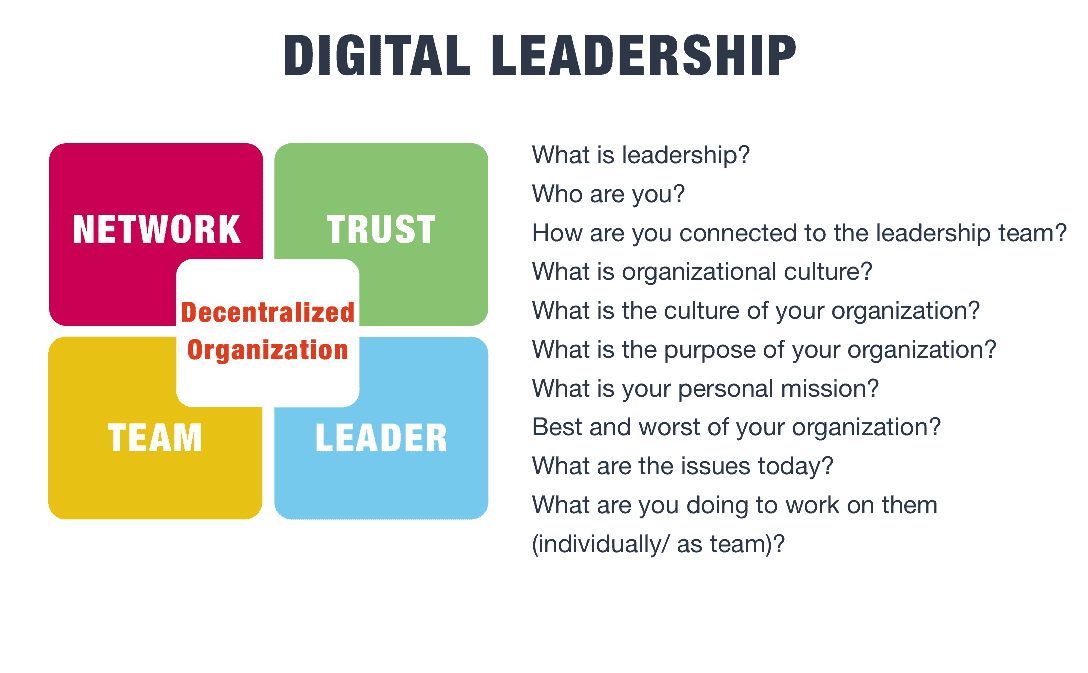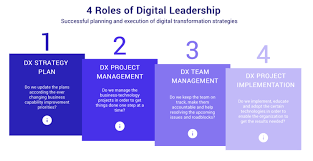Digital transformation leadership isn’t just a buzzword; it’s your ticket to the future. As the pace of change in tech becomes breakneck, you can’t afford to lag. Every decision you make now either catapults your company ahead or leaves you playing catch-up. The role at the helm is clear: See the vision, lead with zest, and weave tech into your business fabric.
You’re not just installing new software; you’re re-engineering mindsets and processes. Your task: Bind teams, ripen ideas, and stay nimble. Embrace this, and your company won’t just survive; it will thrive. So, how do you light the path and keep the gears turning smoothly? Let’s dive into the dynamics that make digital transformation leadership not just effective but exemplary.
The Role of Leadership in Digital Transformation
Embracing a Vision for Digital Transformation
Leaders guide their teams to success. In the digital world, this means shaping a clear and bold vision for the company’s digital future. Picture a CEO or CIO as the captain of a ship. They see the horizon and set the direction. This is crucial for any digital transformation effort. Heads of companies must craft and share a vision that excites and leads everyone forward.
They must also make sure this vision catches on across the company. For this, building a culture that welcomes digital change is key. They support teams wanting to try new tech. They mix units, like IT and marketing, to work together. This way, ideas flow and silos break down. Strong leaders prepare their firms to ride the wave of digital advancement, not sink under it.
Navigating the Challenges of Technology Adoption
Adopting new tech brings hurdles. These hurdles can make or break a company’s move to the digital age. Leaders face concerns about costs, staff training, and changes to work habits. But they must keep their eyes on the big picture. Every new tech can mean more growth, if used right. So, they balance caution with courage.
Smart leaders listen to their teams’ worries and find solutions together. They provide needed tools and training for new tech. They cheer on teams trying new things, even if they sometimes fail. This builds trust. Trust makes staff more open to change. When leaders tackle tech adoption head-on, they set their companies on a path to a future where they stay ahead of the game.
These leaders know tech is just one part of the puzzle. They rely on data to make decisions and shape strategies. With good data, they can spot trends and make more money. Leaders today need to know tech, yes. But they also need to know people. They match tech solutions to staff skills and customer needs.
For a company to truly evolve, its chiefs must be clear on how digital transformations can boost their business. They have to be the ones at the front, leading the charge. They navigate through tech storms, steer their crews with confidence, and keep the ship moving toward a digital dawn. This is the essence of true digital transformation leadership.
Essential Strategies for Successful Digital Transformation
Fostering Cross-Functional Collaboration and Integration
Imagine this: Picture different teams in a company, like music instruments in an orchestra. Just as instruments must work together to play a symphony, teams must do the same for a company to succeed in digital transformation. The secret lies in getting these teams to talk, share ideas, and work as one. This is what we call cross-functional collaboration.
Now, what makes this collaboration work? Simple: people, processes, and technology. We bring together folks from all parts of our company to solve problems. We match their skills to the tasks at hand. The tech we use must help, not hinder, so we choose it wisely.
I tell you, when we get this mix right, magic happens! We innovate faster. We outpace competitors.
Leveraging Customer-Centric Digital Strategies
Now let’s talk about customers. They are the kings and queens in our digital world! So we build our digital strategies with them at heart. What does this mean? It means we listen to what our customers need, like really listen. We think about their lives and how we can make them better with our tech.
We keep customers happy by giving them what they want before they even ask for it. We use data to guess their needs and serve them fast. Our teams work to make sure our customers enjoy every digital minute with us.
A happy customer means a thriving business. It’s the golden rule!
Driving Organizational Change Through Technological Innovation
Role of CIO and CEO in Spearheading Digitization
In the race to the future, the CIO and CEO lead. Together, they set the pace. They make tech a core part of our plan. They grab new tools to stay ahead. It’s like being a captain. They steer the ship to new lands. Both look for what tech can do for us. They show us how to change the way we work.
These leaders build bridges between now and new ways. They make sure we all talk and think together. Like a coach building a winning team, they inspire us to do more. They teach us new tricks. The CIO and CEO show us not just to play the game, but to change it.
They pick the best tech for our goals. They think of what our customers need. And they keep our data safe. It’s a lot, but that’s what leaders do. They see tomorrow and make sure we’re ready.
Championing Change Management in the Digital Era
Change is tough, but we must move with the times. The digital world waits for no one. As leaders, we guide our teams through new tech seas. It’s all about teaching and helping each other. We plan. We train. We learn. And we do it together.
We change our minds to change our work. It’s a shift in how we think and act. Just like coaches, we prepare the team for a big game. Except the game is our work, and we play it every day.
Teamwork shines here. Everyone has a part to play. We join hands across desks and screens. We unite skills from every corner of our place. It’s not just tech folks involved; it’s all hands on deck.
Leaders keep eyes on the prize, helping us to stay focused. They show us to look for answers in the numbers. It’s like a puzzle, and our job is to fit the pieces together.
And the tools! We use tech to talk, to make, and to sell. To learn. To grow. We build what we need for now and for what’s next. This change is not just for now, it’s for keeps.
So here’s our map for this journey: Train on the tech we have. Learn the tech that’s coming. Stick together. Use what we know. And always be ready for the next wave. Because in this digital world, the waves keep coming. And together, we’ll learn to surf.
Cultivating Digital Culture and Competitiveness
Training Executives for Digital Readiness
Executives must grasp tech fast to lead well. They need right digital skills to guide staff. My focus lies in making them ready for this shift. I teach them how to craft strategies for digital transformation. I show them how to spur change in firms. This is key, as they set the tone at the top.
First, I tackle executive leadership in tech innovation. This means showing leaders the tech world’s nuts and bolts. We look at successful digital business models. We see what works. This arms them with ideas to use in their own companies.
I also stress the need for clear vision. What will their firm look like after it changes? They must figure this out. Then, they can share this vision. This gets everyone excited about the change. It paves the way for adopting new tech with less fuss.
A big part is data-driven decision-making. I train execs to use data for smart choices. This helps them to see what’s working and what’s not. We want decisions based on solid info, not just gut feelings. Leaders learn to trust the data, leading to better results.
Last, it’s about fostering a digital culture. Change is hard. But it’s doable with the right mindset. I help leaders to build a place where digital is part of day-to-day work. It becomes the new normal. This makes embracing tech changes much smoother.
Investing in the Future: Proactive Approaches to Digital Disruption
Firms can’t sit still. They must look ahead, always ready for the next big thing. What’s coming next in tech? How can it help or hurt us? These are questions leaders need to ask. Future-proof firms stay on top. They see change as a chance to grow, not a threat.
I teach leaders to stay on their toes. To watch for signs of digital disruption. We talk about transformational leadership qualities. Leaders need these to steer through tech storms.
We look at ways to turn disruption into opportunity. One idea is cloud computing. It brings speed and power to firms. Another is blockchain. It could change how we trust and verify info in our deals.
We can’t forget about cybersecurity. It’s got to be top of mind for bosses. Safety in the digital world is a must. When leaders take it seriously, everyone else does too.
Digital transformation is not one-size-fits-all. It varies by industry. This is why we explore digitization in different fields. Knowing one’s unique landscape helps in crafting the right approach.
It’s about designing digital experiences too. This taps into customer needs. It also brings in fresh revenue streams. That’s why customer-centric strategies are a big deal.
Investing in digital means planning for long-term change. It’s about setting up a digital road map. And it’s about getting everyone on board with this plan. When done right, these moves can make firms strong players in tomorrow’s market.
We’ve covered how strong leaders guide digital changes. Smart bosses hold onto a clear vision and tackle tech hiccups head-on. A team that works together well makes these shifts smoother, keeping customers at the heart of the plan.
Using new tools brings out the best in our work. Big bosses, like CIOs and CEOs, must lead the charge. They push everyone to embrace new methods. We’ve also learned how key it is to prep executives and stay ahead of tech curveballs.
In short, solid leadership, teamwork, and training set us up to win in the digital game. Let’s be the shapers of our tech-savvy future, not just followers. Keep pushing, keep growing, and let’s take on the digital world together.
Q&A :
What is digital transformation leadership?
Digital transformation leadership refers to the combination of strategies, methodologies, and capabilities required to steer an organization through changes brought about by digital technologies. Leaders in this domain need to possess a mix of technology foresight, business acumen, and change management skills to effectively drive transformation initiatives that leverage digital innovations to improve business performance and create competitive advantage.
Why is leadership important in digital transformation?
Leadership is crucial in digital transformation as it underscores the ability to envision, inspire, and execute change within an organization. Transformational leaders play a pivotal role in fostering a culture of innovation, prioritizing digital initiatives, and ensuring that employees across all levels are onboard with the new directions. Strong leadership helps in managing resistance to change, aligning various departments, and securing the resources needed for a successful digital shift.
What skills are needed for digital transformation leadership?
Key skills needed for digital transformation leadership include:
- Strategic thinking and visioning to identify how digital trends can empower business models.
- Strong communication to clearly convey the transformational vision and goals to stakeholders at all levels.
- Change management expertise to help navigate the organization through the transition process smoothly.
- Technical understanding to grasp the implications of digital technologies and their potential impact on the business.
- Team building and talent management to create agile and collaborative teams geared toward innovation.
How can leaders drive digital transformation successfully?
Leaders can drive digital transformation successfully by:
- Creating a sense of urgency around the need for change and the opportunities digital technologies offer.
- Defining a clear digital strategy that aligns with the overall business objectives.
- Encouraging a culture of continuous learning, experimentation, and acceptance of failure as a pathway to progress.
- Leading by example, demonstrating commitment to digital initiatives.
- Engaging employees, customers, and stakeholders in the transformation journey, ensuring their input and feedback are considered.
What are the challenges faced in digital transformation leadership?
Digital transformation leadership challenges include:
- Overcoming resistance to change from employees and sometimes management.
- Ensuring that there is alignment and collaboration between IT and business units.
- Dealing with the rapid pace of technological change and the difficulty in keeping up with emerging digital trends.
- Balancing innovation with risk, as well as managing cybersecurity threats in an increasingly digital environment.
- Aligning existing organizational structures and processes with new digital-first strategies, which often requires significant cultural and procedural shifts.



